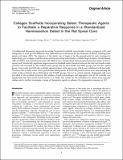| dc.contributor.author | Cholas, Rahmatullah | |
| dc.contributor.author | Hsu, Huping P. | |
| dc.contributor.author | Spector, Myron | |
| dc.date.accessioned | 2012-09-20T19:21:43Z | |
| dc.date.available | 2012-09-20T19:21:43Z | |
| dc.date.issued | 2012-07 | |
| dc.date.submitted | 2012-04 | |
| dc.identifier.issn | 1937-3341 | |
| dc.identifier.issn | 1937-335X | |
| dc.identifier.uri | http://hdl.handle.net/1721.1/73084 | |
| dc.description.abstract | A multifaceted therapeutic approach involving biomaterial scaffolds, neurotrophic factors, exogenous cells, and antagonists to axon growth inhibitors may ultimately prove necessary for the treatment of defects resulting from spinal cord injury (SCI). The objective of this study was to begin to lay the groundwork for such strategies by implanting type I collagen scaffolds alone and incorporating individually a soluble Nogo receptor, chondroitinase ABC (ChABC), and mesenchymal stem cells (MSCs) into a standardized 3-mm-long hemiresection defect in the rat spinal cord. Statistically significant improvement in hindlimb motor function between the first and fourth weeks post-SCI was recorded for the scaffold-alone group and for the ChABC and MSC groups, but not the control group. Four weeks post-SCI, the scaffolds appeared intact with open pores, which were infiltrated with host cells. Of note is that in some cases, a few growth-associated protein 43 (GAP-43)-positive axons were seen reaching the center of the scaffold in the scaffold-alone and ChABC groups, but not in control animals. Angiogenic cells were prevalent in the scaffolds; however, the number of both macrophages and angiogenic cells in the scaffolds was significantly less than in the control lesion at 4 weeks. The results lay the foundation for future dose–response studies and to further investigate a range of therapeutic agents to enhance the regenerative response in SCI. | en_US |
| dc.description.sponsorship | Gates Millennium Scholars Program (Fellowship) | en_US |
| dc.language.iso | en_US | |
| dc.publisher | Mary Ann Liebert, Inc. | en_US |
| dc.relation.isversionof | http://dx.doi.org/10.1089/ten.TEA.2011.0577 | en_US |
| dc.rights | Article is made available in accordance with the publisher's policy and may be subject to US copyright law. Please refer to the publisher's site for terms of use. | en_US |
| dc.source | Mary Ann Leibert | en_US |
| dc.title | Collagen Scaffolds Incorporating Select Therapeutic Agents to Facilitate a Reparative Response in a Standardized Hemiresection Defect in the Rat Spinal Cord | en_US |
| dc.type | Article | en_US |
| dc.identifier.citation | Cholas, Rahmatullah, Hu-Ping Hsu, and Myron Spector. “Collagen Scaffolds Incorporating Select Therapeutic Agents to Facilitate a Reparative Response in a Standardized Hemiresection Defect in the Rat Spinal Cord.” Tissue Engineering Part A (2012): 120904062549001. ©2012 Mary Ann Liebert, Inc. publishers | en_US |
| dc.contributor.department | Harvard University--MIT Division of Health Sciences and Technology | en_US |
| dc.contributor.mitauthor | Cholas, Rahmatullah | |
| dc.relation.journal | Tissue Engineering. Part A | en_US |
| dc.eprint.version | Final published version | en_US |
| dc.type.uri | http://purl.org/eprint/type/JournalArticle | en_US |
| eprint.status | http://purl.org/eprint/status/PeerReviewed | en_US |
| dspace.orderedauthors | Cholas, Rahmatullah; Hsu, Hu-Ping; Spector, Myron | en |
| mit.license | PUBLISHER_POLICY | en_US |
| mit.metadata.status | Complete | |
